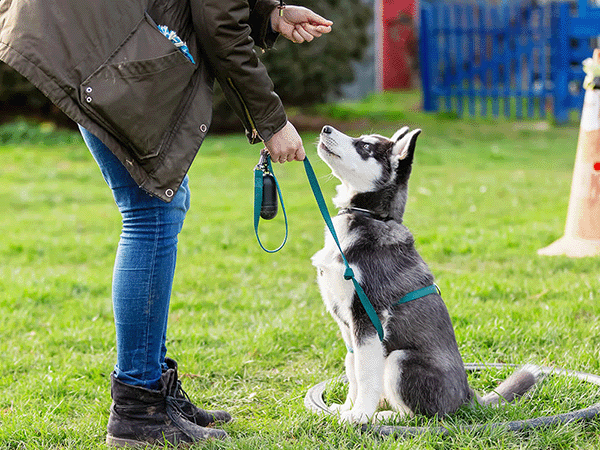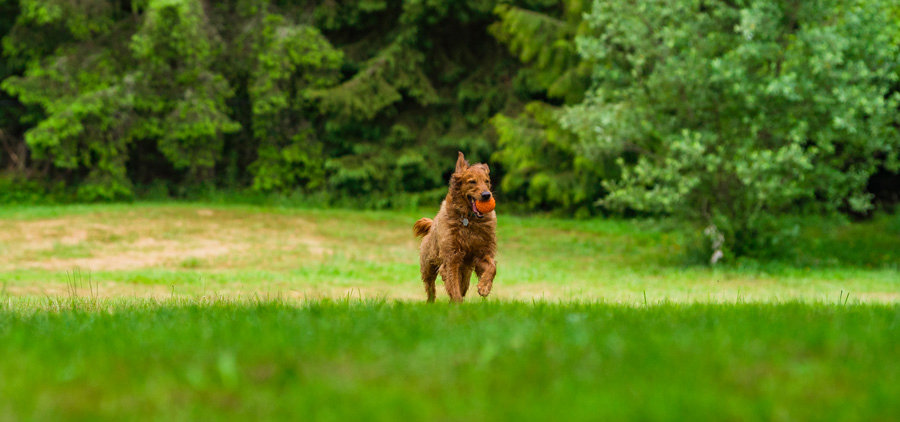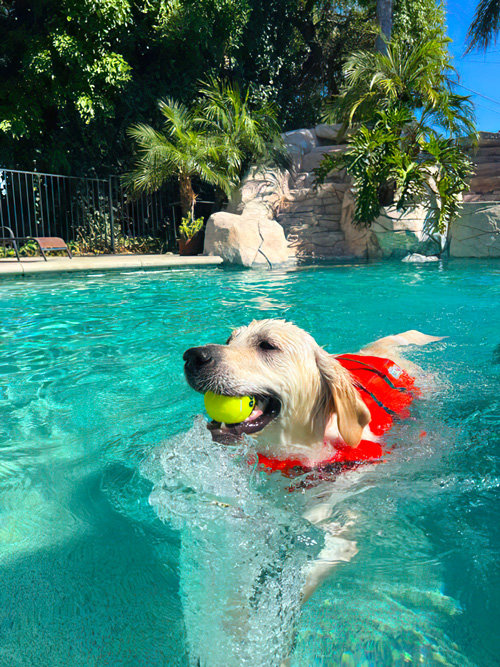Dog Training 101: A Beginner's Guide

You're constantly teaching your dog, whether you realize it or not. They're always learning! So let's make it official and dive into Dog Training 101. This guide covers the basics of how dogs learn, practical training techniques, and tips for handling common behavioral issues. New pet parent or seasoned pro, you'll find something here to strengthen your bond with your furry friend.
That doesn’t mean dog training is simple, though. We know firsthand how overwhelming it can feel—especially if you’re a first-time pet parent. Then the training process is made only more complicated by all the conflicting information out there in the age of the internet… not to mention the huge range of personal training goals you might have.
Maybe you just adopted a new puppy and simply want them to grow into a polite, happy companion. Maybe your adult dog is struggling with an unwanted behavior like leash reactivity, separation anxiety, or even fear aggression. Maybe you’re just interested in understanding more about how your dog learns and developing some training skills.
Whatever the case, we’ve got your back.
Here’s a high level review of everything you need to know to enjoy life with a well-trained dog! While we always recommend working with an in-person professional trainer for any severe issues, this guide should get you on the right track to understand key learning theories. Most dog parents make quick progress when it comes to common issues like potty training and crate training. (More on those and other popular training programs at the very end.)
Let’s dive in!
What are the learning theories in dog training?
Dogs don’t think about the world the same way we humans do.
Our canine companions primarily learn through association. Researchers are coming to believe they do have episodic memories—the ability to recall a specific past event—but probably not to the degree of our own. (That means your pup doesn’t spend time reliving their most embarrassing moments like you might.) Domestic dogs also have poorer short term memories that might prevent them from clearly remembering what happened even just a few minutes ago.
Instead, our canine companions develop new behaviors and form habits through the principles of both operant conditioning and classical conditioning. Almost all dog training is based on these two common learning theories!
Key Takeaways
- Use positive reinforcement: Focus on rewarding desired behaviors to motivate your dog and build a positive training experience.
- Communicate clearly with your dog: Pay attention to your body language, tone, and the clarity of your cues. A consistent approach helps your dog understand what you're asking.
- Don't hesitate to seek professional help: A certified trainer can provide personalized guidance and address specific training challenges or behavioral issues.
Operant conditioning
Operant conditioning is a learning theory developed by B.F. Skinner. It’s sometimes called “trial and error” or “consequence” learning. At its simplest, operant conditioning is what happens when our dogs learn to associate their behavior with certain consequences.
If a behavior leads to good things? Dogs will perform it more frequently. If a behavior leads to something unpleasant (aversive)? Dogs will perform it less often (and perhaps develop fearful emotions—more on that in the classical conditioning section below).
There are four quadrants of operant conditioning, divided up on two dimensions:
- Whether the consequence is the addition of something (like giving a treat or toy) or the removal of something (like taking away your attention)
- Whether the behavior increases or decreases
If you add something, that’s called “positive”. If you remove something, that’s called “negative”. We know this can be confusing! Try not to think of it in terms of “positive being good” and “negative being bad”. Instead think of it like math class. Positive means addition. Negative means subtraction.
If the behavior increases, that’s called reinforcement. If the behavior decreases, that’s called punishment. Again, try not to think in terms of good and bad. Reinforcement and punishment, in an operant conditioning sense, simply describe whether the behavior has gotten more or less frequent.
Positive reinforcement
The positive reinforcement quadrant of operant conditioning is where you add something to increase a behavior. This is where you should focus most of your training!
Force free or reward-based dog training tries to use as much positive reinforcement as possible to show our dogs what we want them to do. It uses lots of food lures and favorite toys to motivate dogs.This way we can increase behavior we like without creating unpleasant emotions—it’s a highly motivating, low conflict way to train.
Negative punishment
The negative punishment quadrant of operant conditioning is where you remove something to decrease a behavior.
Most good trainers try to avoid the use of punishment. After all, it’s better to teach our dogs what to do instead of what not to do! That said, negative punishment can be unavoidable in our lives with dogs—and it can also be an effective part of training when paired with positive reinforcement for the behavior we do like.
Here’s an example:
- If your dog jumps on you to be pet, you might turn away to remove (negative) your attention in hopes that they jump on you less frequently (punishment).
- Then you might ask your dog to sit instead of jumping, at which point you give (positive) them affection in hopes that they sit more often to greet you (reinforcement).
Negative reinforcement
The negative reinforcement quadrant of operant conditioning is where you remove something to increase a behavior.
This might seem confusing—but you’re probably pretty familiar with negative reinforcement in your own life, even if you’ve never heard the scientific terms before. If you buckle your seatbelt so that your car stops beeping at you? That’s negative reinforcement. The removal (negative) of the annoying seatbelt alarm sound increases (reinforcement) the behavior of you buckling up.
Generally, good dog trainers avoid negative reinforcement in their training because it requires an aversive stimulus (like leash pressure) to be present at the start of a behavior. We want to minimize our dogs’ unpleasant emotions as much as possible.
Positive punishment
The positive punishment quadrant of operant conditioning is where you add something to decrease a behavior.
This is punishment in the most familiar sense that we think of. (Though try to remember to keep your personal associations out of it at this point—again, we’re simply focusing on a decrease in behavior when we talk in an operant conditioning sense—and we’ll talk more about emotions in classical conditioning below). In positive punishment, you add something that your dog finds aversive in that moment to decrease the behavior they performed right before the consequence.
It’s important to remember that if we aren’t thoughtful, even things we want to be reinforcing can inadvertently be punishing! A great example of this is a dog who doesn’t enjoy being patted directly on top of the head. A doting pet parent might think they’re rewarding their pet for coming when called when they pet them between the ears—but the dog might actually dislike the sensation and decrease their behavior moving forward.
Generally, the use of aversives in dog training, and especially aversive-based training where punishment or corrections are used regularly, has fallout. This is because the dog often starts to associate the unpleasant consequences with their owner, trainer, or the environment itself. This process is called classical conditioning.
Classical conditioning
Pretty much everyone has heard of Pavlov’s dogs. The scientist taught his dogs to salivate at the sound of a bell that always predicted food. But technically, “taught” isn’t quite the right word.
While operant conditioning deals with behavior (things your dog is aware of and actively chooses to do) classical conditioning deals with reflexes and emotions (things your dog can’t control). Pavlov’s dogs didn’t drool on purpose. They had just come to associate the sound of a bell with the arrival of food. Their bodies began to treat the unrelated stimulus (the bell) as a biologically relevant one (food) and have the same response to it.
Classical conditioning happens all the time with our dogs. We can never just “turn it off!” This means it’s important to be aware of what emotions we’re creating in our pets as we train them.
One common classical conditioning example is dogs getting excited when they hear the doorbell ring. They’ve come to associate the noise of the bell with the arrival of guests who give them affection, which increases their arousal in anticipation. They aren’t thinking about their behavior at this moment. They know the doorbell predicts visitors regardless of what they do.
Remember your dog doesn’t experience the world like a human
Beyond learning theory basics, here are a few things to keep in mind when thinking about how to train your dog.
- Your dog likely pays more attention to your body language than the sounds you make. If you accidentally move your hand a certain way while giving a verbal cue, they might become confused. This is especially important if you notice them struggling to differentiate behaviors as you train!
- Your dog also pays more attention to the tone of your voice and any intense moments of inflection (think about the “t” sound at the end of “sit”) than the entire word you say. Remember this when deciding what cues to use for different behaviors. If you pick too many that sound similar, your dog might struggle simply because they’re confused. It’s our job to be clear with them!
- Canines have highly developed senses of smell. It can be difficult for them to resist the urge to sniff, especially in environments that have seen lots of other dogs or people (like public parks).
- It’s easier to train your dog to perform behaviors that are already natural to them (like picking up things in their mouth, sitting, moving their bodies in normal ways, and so on) than to teach skills that go against their typical tendencies (like walking on their hind legs or balancing things on their sensitive facial tissues). Keep this in mind as you decide what to prioritize, and always make sure you reward your dog generously!

What are dog training rewards and reward markers?
When we ask our dogs to work for us, it’s only fair we pay them. Right? This is especially true if we want them to perform behaviors that are unnatural or go against their instincts—like staying still while lots of exciting things happen around them at a busy restaurant patio, resisting the urge to chase prey, or letting us trade them for a high-value resource.
Common training rewards
Rewards are things 1) our dogs love that 2) are easy for us to give them during a training session.
Common reinforcers include:
- Store-bought dog treats
- Small pieces of human food (like meat or cheese)
- Your dog’s kibble (if they’re particularly food motivated, have a sensitive stomach, or you need to be calorie conscious)
- A favorite toy
Important note: Not every reward is always reinforcing
Remember when we talked about the operant conditioning quadrants? Our dogs are the ones who decide what is and isn’t reinforcing to them. Just because we offer them something we think they should like doesn’t mean it will actually increase the desired behavior moving forward!
How to choose the right rewards for your dog
If possible, let your dog decide what they like best. Consider setting out multiple rewards, seeing which one they go to first, and choosing that to teach new behaviors! (You can also vary between a few favorites to keep them interested.)
The more excited your dog is for their reinforcer, the more motivated they’ll be during your training session. And the faster they’ll learn!
Reward markers can help your dog understand what you want them to do
If you’ve heard of “clicker training” (first popularized by marine mammal trainers) then you’ve been exposed to the idea of a reward marker.
In technical terms, a marker is a conditioned stimulus that predicts a primary reinforcer. Put more simply? A reward marker is a sound or signal that “marks” exactly what your dog did to earn their reinforcement. This makes it possible for us to communicate clearly during training sessions—even if we’re unable to deliver a treat precisely when our dogs offer the right behavior. Reward markers are great for everything from basic obedience training to complex tricks.
Common reward markers include:
- Clickers
- “Yes”
- “Good”
- A thumbs up (particularly useful for deaf dogs)
- Other easy-to-make noises
No marker is inherently better than the others. What matters is that you pick one that works for you and stick to it! Consistency is key.
How to charge your reward marker
To make sure your dog understands that your marker sound or signal predicts a reward, spend a few sessions conditioning them to the stimulus. (If you already use reward markers in your training, skip on to the next section.)
You can charge your dog’s reward marker by:
- First making your noise or visual signal
- Pausing for a second
- Then giving your dog their reward—this turns your chosen marker into a predictor of good things to come
- Repeating multiple times!
Eventually your dog will start to respond to the noise itself—they might run towards you before you even reach for their treat or toy. This indicates that they’re forming the right association.
How to use your dog’s reward marker in a training session
Once your dog is conditioned to your chosen reward marker, you can start using it in training sessions to teach new skills.
It’s important to mark the right behavior the instant your dog performs it. Accurate timing makes for more effective teaching! And remember to always follow your marker with a reward. You have about three seconds to deliver reinforcement, give or take, to keep up your dog’s conditioned association.
You can mark complex behaviors during trick training sessions or just simple things throughout the day, like your dog offering you eye contact on a walk.

Dog Training 101: Basic Commands and Their Importance
Basic commands are the foundation of good dog manners. They help you communicate clearly with your pup, keeping them safe and setting them up for success in various situations. Think of these commands as the building blocks for a strong, positive relationship with your dog.
7 Essential Commands to Teach Your Dog
These seven commands, recommended by sources like Good Housekeeping, are beneficial for dogs of all ages and breeds. Mastering these will make everyday life with your dog much smoother.
Sit
“Sit” is often the first command taught because it’s relatively easy for dogs to learn and serves as a basis for many other commands. It’s a great way to manage excited greetings and create a sense of calm.
Stay
“Stay” builds on “sit” and teaches your dog impulse control. This command is essential for safety, preventing them from running into the street or other dangerous situations. A solid "stay" can also be helpful when visiting new places, like the dog parks listed on Sniffspot.
Come
A reliable recall (“come”) is crucial for off-leash adventures at a safe, enclosed area like a Sniffspot and for general safety. It gives you peace of mind knowing you can call your dog back to you in any situation.
Heel
“Heel” teaches your dog to walk politely beside you on a leash, making walks more enjoyable for both of you. It prevents pulling and lunging, creating a more harmonious experience.
Off
“Off” is useful for preventing your dog from jumping on people or furniture. It teaches them appropriate boundaries and respectful interactions.
Leave It
“Leave it” helps your dog resist the temptation of potentially harmful items or distractions. This command can prevent them from eating something dangerous on a walk or getting into trouble at home.
No
“No” is a general command to stop an unwanted behavior. It’s important to use this command sparingly and clearly, so your dog understands its meaning. Overusing "no" can dilute its effectiveness.
Understanding "Leave It" vs. "No"
While both discourage unwanted behaviors, “leave it” is specific to ignoring something, while “no” is a more general command to stop. Using “leave it” consistently for ignoring items can help avoid confusion, as suggested by Good Housekeeping.
Suggested Training Order for Commands
Starting with “sit” is often recommended, as it’s a simple command that builds a foundation for others. From there, you can progress to “stay,” “come,” and other commands based on your dog’s individual learning pace. The RSPCA offers additional tips on training order and techniques.
Effective Training Techniques and Tips
Effective training goes beyond simply knowing the commands. It involves understanding how your dog learns and using techniques that motivate and encourage them. Positive reinforcement, consistency, and patience are key.
Specific Training Techniques for Each Command
Each command may require slightly different techniques. For example, teaching "sit" might involve luring your dog with a treat, while "come" might require more distance, enthusiasm, and a high-value reward.
Minimizing Distractions During Training
Start training in a quiet environment with minimal distractions. As your dog progresses, gradually introduce distractions to help them generalize their learning to different situations. This gradual exposure helps build confidence and focus. If you're looking for a quiet, controlled environment for training, consider renting a private Sniffspot.
Varying Training Locations and Times
Training in different locations and at different times of day helps your dog learn to respond consistently, regardless of the environment. This prevents them from associating commands with only one specific place or time.
Preventing Unwanted Behaviors Proactively
Management is a key part of training. By anticipating and preventing unwanted behaviors, you can set your dog up for success. For example, if your dog tends to jump on guests, put them on a leash before opening the door.
Using a Leash as a Training Tool
A leash can be a valuable tool for guiding your dog and preventing unwanted behaviors during training. It provides gentle control and helps you communicate clearly.
Ending Training Sessions Positively
Always end training sessions on a positive note, even if it’s just a quick review of a command your dog already knows. This helps maintain their motivation and enthusiasm for learning.
Additional Tips for Success
The Importance of Exercise
A tired dog is often a more receptive learner. Ensure your dog gets enough physical exercise and mental enrichment to burn off excess energy, making them more focused during training sessions. Check out Sniffspot for dog-friendly parks and trails near you.
Avoiding Hot Surfaces
Be mindful of hot surfaces, especially during warmer months. Avoid walking your dog on hot pavement, which can burn their paws. Dog water parks can be a great way for your dog to cool off and have fun.
Utilizing "Away" and "Wait" Commands
While not part of the core seven, commands like "away" (for moving away from something) and "wait" (for pausing before proceeding) can be helpful additions to your training repertoire. "Wait" can be particularly useful before entering or exiting doorways or cars.
Training Duration and Frequency
Recommended Session Duration
The Spruce Pets recommends keeping training sessions short and sweet, around 5-10 minutes, especially for puppies or dogs with short attention spans. Multiple short sessions throughout the day are more effective than one long session.
Optimal Training Frequency
Consistency is key. Aim for daily training sessions, even if they’re just a few minutes long. Regular practice reinforces learning and helps build good habits.
Crate Training Benefits
Why Crate Train Your Dog?
A crate can be a den-like sanctuary for your dog, offering a sense of security and comfort. The RSPCA highlights the benefits of crate training for providing a safe space and aiding in housetraining.
Seeking Professional Help
Types of Professional Dog Training Help
There are various types of professional dog training help available, including group classes, private lessons, and even online consultations. The Spruce Pets recommends considering professional help for severe behavioral issues. If you're looking for trainers in your area, you can check out resources like Sniffspot's list of top dog trainers.
Understanding How Dogs Learn
Dogs learn differently than humans. Understanding the principles of operant and classical conditioning can help you train more effectively and build a stronger bond with your dog. You can learn more about popular dog training methods on Sniffspot's blog.
Essential Tips for New Dog Owners
The 3-3-3 Rule for Adjusting to a New Home
The 3-3-3 rule is a helpful guideline for understanding the adjustment period a newly adopted dog goes through. It represents the three days, three weeks, and three months it can take for a dog to fully acclimate to their new environment. For more tips on welcoming a new dog home, visit the Sniffspot blog.
The 5-Second Rule for Petting
The 5-second rule is a simple way to respect your dog’s boundaries. If you reach out to pet a dog and they don’t lean into your touch within five seconds, it’s a sign they might not be comfortable with being petted at that moment. Learning to read your dog's body language is a key part of responsible pet ownership.
General pet dog training principles
Be patient and keep things fun!
Before working with your dog, make sure you’re in a good headspace. It’s not always easy to communicate with another species. Even simple behaviors like sitting, giving us eye contact, or lying down on cue can confuse our pets at first!
Be prepared to take things slowly and keep your training sessions upbeat. Offer lots of praise and affection when your dog makes an effort—and keep things simple to get more buy-in from your dog, especially if they are an adolescent.
Minimize distractions when you start a new behavior or skill
Remember that our dogs have very sensitive noses and ears. The busy park is not the place to start teaching a brand-new behavior. Your quiet living room, on the other hand? Perfect.
Keep distractions at a minimum until your dog shows you they understand what you’re asking. At that point you can slowly increase the difficulty and work up to more challenging environments.
Know that dogs can struggle to generalize behaviors
Dogs often struggle to generalize behaviors. This means they might be able to follow basic cues in a familiar environment but still struggle to perform out and about. Don’t worry: This is completely normal, and it doesn’t mean anything is wrong with your training! It just means your dog needs more practice to understand that “down” always means to lie down or that “come” always means to return to you regardless of where they are.
This is important to note because it’s easy to feel frustrated when we feel like our dogs should know something but aren’t acting on it. In most cases, it’s not that our pets are purposely disobeying. They just haven’t fully generalized our cues yet!
That leads us well into our next principle of pet dog training…
Remember your dog doesn’t do things to “spite” you
Old-school dog trainers used to think that our canine companions were constantly trying to be in charge of our homes and “dominate” their surroundings. As research has evolved, we’ve learned that’s not true. In fact, the vast majority of “bad” behavior in our pets comes from simple confusion or fear.
Your dog doesn’t experience the world like you do. They don’t have an automatic understanding of human society and social norms. They’re doing their best to function in a modern environment that can be confusing and at odds with their deeply ingrained natural instincts. In short: Try to show your dog empathy! This is especially important if they’re struggling with a specific behavioral problem.
Short, frequent sessions will keep you and your dog from burning out
Dog training can be a lot of work—for both your companion and for you! It’s a good idea to keep any specific, skill-focused sessions short to avoid pushing either of you to the point of exhaustion. Consider planning for just five to ten minutes of active training a day. Some common times to fit this into your dog owner schedule are:
- During one of your dog’s mealtimes
- Before, after, or even during your dog’s evening walk
- On your lunch break if you’re able to work remotely or visit home midday
Try to always end on a good repetition (if your dog is struggling with a new behavior, take a step back and ask them to perform something they know really well) so that you both leave each session on a happy note. This will keep you motivated to dive in next time!
Common dog training goals, problems, and techniques
Let’s take a look at some common dog training goals. Read on to learn about potty training, crate training, basic cues, and more.
Potty training
Every puppy needs to be house trained growing up. (And some adult dogs still struggle to only use the bathroom outdoors.) We know how difficult it is to enter a room only to be greeted by a big, smelly accident. This is one of the most common and most frustrating parts of dog ownership. Struggles in the house training department can take a toll on our own stress levels, routines, and homes — but we promise the process is worth it in the end.
You can read more in our potty-training focused articles:
- What is and How to Handle Potty Training Regression
- How to House Train an Adult Dog
- How to Train a Dog to Pee on Pad
- Bell Training for Dogs
Crate training
Crate training is a vital skill for dogs to have. There are many situations where your dog might need to be comfortable in a confined space for a little while, ranging from vet visits to traveling in the car to staying at hotels out of town to attending sports trials and more. When trained through positive reinforcement, the crate can become a safe space for your dog—it can even make training other skills (or working on a behavioral modification plan) easier!
You can learn more in our crate training article below. A greater range of information is always available on the dog training section of our blog, too.
Basic cues
Teaching your dog some basic skills can open up your world. If your pet is able to sit, lie down, and come when called, you’ll be able to take them more places with you! They can enjoy the freedom to frolic off lead and join you while meeting a range of new family and friends. Plus even this simple training can do wonders for building a lasting, positive relationship between you and your companion.
Take a look at some of our articles on teaching basic cues below.
- How to Train a Dog to Lie Down: Teaching Your Dog a Basic Cue
- Reliable Recall Training: Teaching Your Dog to Come
- Complete Guide To Dog Training Hand Signals
Working through behavioral problems
Many dogs struggle with some sort of behavioral problem throughout their lives. This is especially true in our modern human world — in fact, the prevalence of things like dog reactivity is one of the reasons Sniffspot was founded in the first place. We’ve put together a huge collection of articles on everything from leash reactivity to fear regression and more.
Professional dog trainers are here to guide you
When in doubt? Professional trainers have your back! Helping you and your furry companion live your best life together is exactly what experienced force free trainers are here for.
If you and your dog are struggling with anything—as simple as polishing up one of their basic cues or as complicated as devising a plan to treat severe reactivity — reach out to a professional who can guide you one on one.
Trainer Review of this Article
There is so much misinformation out there, we want to make sure we only provide the highest quality information to our community. We have all of our articles reviewed by qualified, positive-only trainers.
This is the trainer that reviewed this article:
Beth Joy
CPDT-KA, PMCT
Owner and Lead Trainer Unleashed Joy Dog Training – Mt. Airy, MD.
Certified Professional Dog Trainer (CPDT-KA)
www.unleashedjoy.com
Related Articles
Frequently Asked Questions
What's the difference between classical and operant conditioning? Operant conditioning focuses on how dogs learn through consequences, associating actions with positive or negative outcomes. Classical conditioning, on the other hand, deals with involuntary responses, like a dog learning to associate the doorbell with visitors and getting excited. One shapes voluntary behavior, the other automatic reactions.
My dog seems to understand a command at home, but not in other places. Why? This is a common issue called a lack of generalization. Your dog might understand "sit" in your living room, but they haven't yet connected it to the same action in different environments. Keep practicing the command in new locations to help them understand it applies everywhere.
Are there any risks to using punishment in dog training? While sometimes unavoidable, punishment can create negative associations for your dog, potentially linking unpleasant feelings to you, the training environment, or even the command itself. It's generally more effective to focus on positive reinforcement, teaching your dog what to do rather than what not to do.
What's a reward marker and how do I use one? A reward marker is a distinct sound or signal (like a clicker or the word "yes") that tells your dog exactly when they've performed the desired behavior. It's followed immediately by a reward, creating a clear link between action and positive reinforcement. This helps your dog learn faster and more accurately.
How long should training sessions be? Keep training sessions short and engaging, ideally around 5-10 minutes, especially for puppies or dogs with shorter attention spans. Multiple short sessions throughout the day are more effective than one long, overwhelming session. End each session on a positive note to keep your dog motivated.
Most recent articles
Related articles
Top dog guides per area
Dog training guides

Dog Food Aggression: Why You Shouldn't Punish It
Does your dog ever growl when you walk by their food dish? Maybe they get possessive of treats, carrying them far away and giving you side-eye when you start to approach — or snarling at your other pets or children if they get too close.

Best Dog Fields in the US: 25+ Wide-Open Spaces for Your Pup to Run Free
The best dog fields in the US offer something that traditional enclosed parks simply can't match: acres of open space where your pup can truly stretch their legs and run at full speed. From Colorado's 470-acre prairie meadows to Tennessee's award-winning "Outback," these wide-open spaces allow dogs to roam, explore, and exercise naturally while engaging instincts that cramped urban parks suppress.

The Ultimate Guide to Scent Training for Dogs
Your dog's nose is an amazing tool. Did you know they have 40 times the olfactory receptors than humans? Scent training for dogs taps into this superpower, turning everyday moments into exciting sniff-fests. It's enriching for all types of dogs – reactive, shy, or simply adventurous. Ready to explore the world of scent work for dogs? Let's get started.

Service Dog Training Costs: DIY vs. Pro
More than 80 million Americans rely on their service dogs to help them navigate the world. Task-trained assistance animals perform a huge range of life-changing—in many cases, life-saving—services: These dogs act as eyes for visually impaired handlers, provide mobility support, alert to seizures and blood sugar crashes, interrupt anxiety attacks, remind their people to take medications, and so much more.

How to Deal With Puppy Potty Training Regression
You thought those dreaded middle-of-the-night potty breaks were over. You were finally free from cleaning up puppy puddles. Then, suddenly, your furry friend starts having accidents again. It's frustrating, right? This puppy potty training regression is more common than you think. Don't worry; we'll help you get your pup back on track. We'll cover the common causes, offer practical solutions, and give you actionable steps to tackle this challenge together.

Dirty Dog Syndrome: Causes, Solutions, and Prevention
It's a cringe-worthy moment every dog owner dreads: your furry friend chowing down on something truly disgusting. If your dog has a penchant for poop, you're dealing with coprophagia. It's more common than you think, and thankfully, often manageable. This article explores the reasons behind dirty dog syndrome, from instinct to learned behavior. We'll also give you practical tips to help break this unpleasant habit.

How to Train Your Rescue Dog: A Complete Guide
* All Sniffspot articles are reviewed by certified trainers for quality, please see bottom of article for details *
Dog enrichment guides

Best Dog Water Parks in the US: 15+ Amazing Splash Destinations for Your Pup
Do you have a water-loving dog looking to burn some energy? There are countless dog parks to visit throughout our country — but some of them become far too hot in the midday sun to be safe for your pets to play. That’s why we’ve put together a list of some of the best dog water parks throughout the United States! At these locations, your pup can frolic, splash, and swim to their heart’s content.

Best Dog Fields in the US: 25+ Wide-Open Spaces for Your Pup to Run Free
The best dog fields in the US offer something that traditional enclosed parks simply can't match: acres of open space where your pup can truly stretch their legs and run at full speed. From Colorado's 470-acre prairie meadows to Tennessee's award-winning "Outback," these wide-open spaces allow dogs to roam, explore, and exercise naturally while engaging instincts that cramped urban parks suppress.

Best Toys for Herding Dogs: Keeping Your Pup Happy & Engaged
Herding dogs are amazing, intelligent companions. But that also means they need more than just a simple game of fetch. Finding the right toys for herding dogs is key to keeping them happy and stimulated. This article explores some of the best toys for herding dogs, including options specifically for breeds like Border Collies and Australian Shepherds. We'll help you discover the perfect herding toys for dogs to tap into their natural instincts and keep them entertained for hours.

Tough Dog Toys for Aggressive Chewers: A Practical Guide
Does your dog destroy every toy you give them? Is your house littered with the remnants of plush toys? Are you tired of wasting money on "indestructible" dog toys for aggressive chewers that don't last? Then this post is for you. We'll cover everything you need to know about finding the best dog toys for aggressive chewers, so you can finally give your pup something safe, durable, and fun.

Daily Exercise Calculator: How Much Exercise Does Your Dog Need?
Everyone knows dogs need exercise, but how much is enough? Walks are great, but creating a truly balanced fitness plan means understanding your dog's specific needs. This post helps you develop a daily exercise calculator for your dog, considering breed, age, and lifestyle. We'll cover fun activities, understanding exercise intensity, and recognizing when your pup has had enough. Let's create a plan that keeps your dog happy and healthy!

Complete Guide To Herding With Dogs
* All Sniffspot articles are reviewed by certified trainers for quality, please see bottom of article for details *

Dog Enrichment Activities: The Ultimate Guide
Ever feel like your dog is restless or bored? They may be getting enough exercise, but still need more. That's where enrichment activities for dogs come in. Giving your dog opportunities to sniff, explore, and problem-solve can make a world of difference. Whether you have a puppy, adult, or senior dog, enriching their environment is key for their well-being. Let's explore how to add cognitive enrichment for dogs, even tailoring activities to your dog's breed with breed specific enrichment and fun enrichment games for dogs.
Dog reactivity guides

Rottweiler Aggression: Truth vs. Myth
Many dogs have gotten a bad reputation over the years for being "dangerous breeds." Rottweilers are among them. Like pit bulls and other large, blocky-headed types of dogs, these powerful and beautiful animals are often assumed to be aggressive.

Best Dog Fields in the US: 25+ Wide-Open Spaces for Your Pup to Run Free
The best dog fields in the US offer something that traditional enclosed parks simply can't match: acres of open space where your pup can truly stretch their legs and run at full speed. From Colorado's 470-acre prairie meadows to Tennessee's award-winning "Outback," these wide-open spaces allow dogs to roam, explore, and exercise naturally while engaging instincts that cramped urban parks suppress.

What Is a Reactive Dog? A Practical Guide for Owners
Does your dog suddenly transform into a barking, lunging Tasmanian devil on walks? It's stressful for both of you. If this sounds familiar, you might have a reactive dog. Understanding what is a reactive dog is the first step to calmer walks. We'll explore the common triggers and give you actionable strategies to manage and modify this behavior. Let's turn those stressful walks into enjoyable outings.

How to Socialize a Reactive Dog: A Step-by-Step Guide
Does your dog display reactivity to other pets or people? Maybe they’re a new rescue pup and are still settling into your home. Or they were sick growing up, so you missed their critical socialization period. Possibly they’ve had a bad experience after being raised as a normal puppy.

What Is a Reactive Dog? A Complete Guide
Is your dog overly excited or fearful around other dogs? Do they bark, lunge, or whine? You might have a reactive dog. Many dog owners face this challenge. Understanding what a reactive dog is is the first step to helping them. This guide explores the common causes of dog reactivity, explains what makes a dog reactive, and offers practical tips and resources. Let's work together to build a stronger bond with your dog and enjoy stress-free walks.

9 Best Online Communities for Reactive Dog Parents
Does your dog's reactivity make walks stressful? You're not alone. Many dog owners face similar challenges. This guide offers practical advice and support for managing reactivity, including finding the best online dog training for reactive dogs. We'll connect you with reactive dog support groups, share training tips, and explore resources like the best dog training app for reactive dogs. Let's build a stronger bond with your dog, together.
* All Sniffspot articles are reviewed by certified trainers for quality, please see bottom of article for details *
How To Groom a Reactive Dog
* All Sniffspot articles are reviewed by certified trainers for quality, please see bottom of article for details *
Sniffspot community guides

The State of Public Dog Parks Across the United States
From 2009 to 2020, there was a 40 percent increase in the development of public dog parks. Designated spots for canine exercise have become commonplace in every major city in North America — many pet owners won’t even consider renting an apartment that doesn’t have its own fenced-in pet area for their canine companions.

Best Dog Fields in the US: 25+ Wide-Open Spaces for Your Pup to Run Free
The best dog fields in the US offer something that traditional enclosed parks simply can't match: acres of open space where your pup can truly stretch their legs and run at full speed. From Colorado's 470-acre prairie meadows to Tennessee's award-winning "Outback," these wide-open spaces allow dogs to roam, explore, and exercise naturally while engaging instincts that cramped urban parks suppress.

How This Family is Affording Their Dream Property Through Renting it Hourly to Dogs
Thousand Oaks, California has been a safe haven for Sniffspot host, Jen, since childhood. Having grown up in busy Santa Barbara, Jen, an introvert from an early age, would seek out solitude and serenity away from tourists attractions and droves of people visiting from elsewhere. “My grandparents own 60 acres about a 30 minute drive from here, and I grew up spending every summer and every holiday visiting them on the ranch,” Jen explained. “In Santa Barbara, we wouldn't go to the beach on the weekend because that's where everybody was, so you'd find places off the beaten path where the tourists weren't. For me, the ranch was just my happy place.”

Host Tips: Ellen K. What Makes Sniffspot Successful for Me
Ellen is the host of Country Pasture Getaway, one of Sniffspot's most popular sniff spots. She has taken the time to write up the lessons she has learned about how to be a great sniff spot host.

How this Oregon Farmer is Making a Business From Renting Her Land to Dogs
Just 20 minutes outside of the busy city of Portland, Oregon, and settled right on the banks of the Columbia River, you’ll find what countless visitors have flocked to the area in search of – mountain views, crisp, clean air, and running water for miles. What you might not expect to find, however, is a hidden oasis designed just for dogs and their people, owned and operated by a farming couple and enjoyed by visitors on two legs, and four.

Host Tips: Fran T. Providing Great Guest Service at our Spot
Fran is the host of Ranch Setting, one of Sniffspot's most popular spots. She has taken the time to write up the lessons she has learned about how to be a great Sniffspot host.

How Sniffspot Helped a Nervous Rescue Work Through His Fears and Change His Family’s Life
This is the story of a family and dog rescuing each other.
Top dog trainers in the US

The Best Dog Trainers in the United States of 2025
This is a list of the top dog trainers in the United States, based on votes from the Sniffspot community and the general public.
The Best Dog Trainers in Seattle, WA of 2025
This is a list of the top dog trainers in Seattle, WA, based on votes from the Sniffspot community and the general public.
The Best Dog Trainers in Portland, OR of 2025
This is a list of the top dog trainers in Portland, OR, based on votes from the Sniffspot community and the general public.
The Best Dog Trainers in Los Angeles, CA of 2025
This is a list of the top dog trainers in Los Angeles, CA, based on votes from the Sniffspot community and the general public.
The Best Dog Trainers in New York, NY of 2025
This is a list of the top dog trainers in New York, NY, based on votes from the Sniffspot community and the general public.
City dog parks guides

Top 10 Indoor Dog Parks: A US Guide
Looking for a space to play with your dog no matter what the weather’s like outside? Look no further than our list of the best indoor dog parks in the United States! These climate-controlled spaces are growing in popularity as pet ownership increases throughout the country. As a bonus, many of them also offer dog training, boarding, grooming, or daycare services on the premises.

Best Dog Fields in the US: 25+ Wide-Open Spaces for Your Pup to Run Free
The best dog fields in the US offer something that traditional enclosed parks simply can't match: acres of open space where your pup can truly stretch their legs and run at full speed. From Colorado's 470-acre prairie meadows to Tennessee's award-winning "Outback," these wide-open spaces allow dogs to roam, explore, and exercise naturally while engaging instincts that cramped urban parks suppress.

Best Dog Parks in the US: Ultimate Guide to Public & Private Off-Leash Adventures
Is your pup giving you those pleading "let me run free" eyes? Whether you're a new dog parent or a seasoned pro looking for fresh adventures, finding the perfect off-leash paradise for your furry friend can feel ruff! From sun-soaked California beaches where your water-loving lab can make a splash to mountain trails in Vermont where your adventure buddy can chase every scent, we've sniffed out the 15 best dog parks across America.

Dog Parks Near Me: Las Vegas Edition
Looking for the perfect dog park near me in Las Vegas? You're in luck! This guide explores all the best options for your pup, from public dog parks to private dog parks near me on Sniffspot. We'll help you find the ideal spot for playtime, socializing, and fresh air. Plus, we'll cover essential etiquette and safety tips to ensure a happy visit for everyone. Get ready for some tail-wagging fun!

Top Sniffspot Locations: Find the Perfect Dog Park
Looking for the perfect dog park? Whether you need a wide-open public space or a private, fenced-in spot, this guide will help you find the best dog parks across the US. We'll cover top-rated public parks, the perks of private dog parks, and even explore Sniffspot locations – giving your pup a safe and fun place to play. Ready to find your dog's new favorite spot? Let's go!

Sniffspot: Portland's Best Private Dog Parks
Ready to discover Portland's best dog parks? Whether you're looking for a public park or the unique experience of a private Sniffspot, this guide has you covered. We'll help you find the perfect spot for your pup, with tips on what to bring, how to prepare, and even understanding dog body language. Plus, we'll explore some top Portland dog parks, including public and Sniffspot options, so you can plan your next dog-friendly adventure in the City of Roses.
Portland Dog Parks: Public & Private Options
This page is about public city dog parks and also includes Sniffspot private dog parks. Sniffspot is the largest network of private dog parks for rent in the world!
Small Dog Park Guide: Tips for Finding the Perfect Spot
Finding the perfect dog park for your small breed can be ruff! Big dog parks can be overwhelming, even dangerous, for little pups. This comprehensive guide helps you sniff out the best small dog parks for your pint-sized companion, covering everything from essential safety checklists to top recommendations for small dog parks across the US—including both public spots and private dog parks.
Dogs breeds

German Shepherd Dogs: Insights From Real Dog Owners
The German Shepherd Dog (GSDs) are known for their intelligence, loyalty, and striking appearance. They're also incredibly versatile, excelling as working dogs and devoted family companions. This guide covers everything you need to know about GSDs, from understanding their unique traits and rich history to practical advice on training and care. So, whether you're a seasoned GSD owner or just starting your research, let's explore this remarkable breed together.

Best Dog Fields in the US: 25+ Wide-Open Spaces for Your Pup to Run Free
The best dog fields in the US offer something that traditional enclosed parks simply can't match: acres of open space where your pup can truly stretch their legs and run at full speed. From Colorado's 470-acre prairie meadows to Tennessee's award-winning "Outback," these wide-open spaces allow dogs to roam, explore, and exercise naturally while engaging instincts that cramped urban parks suppress.

Labrador Retriever: Ultimate Guide by Owners
Discover the Labrador Retriever, a breed celebrated for its playful nature, affectionate temperament, and trainability. Labradors are known for their friendly demeanor and adaptability, making them perfect family companions and versatile working dogs. As one of the most popular types of retrievers, Labs are ideal companions for various lifestyles and are recognized by the American Kennel Club (AKC) as an excellent breed for families.

Golden Retriever Advice: The Complete Owner's Guide
Golden Retrievers: they're gorgeous, playful, and incredibly popular. But before you welcome one into your home, you need the right golden retriever advice. This guide draws on the wisdom of nearly 10,000 Golden Retriever owners, offering practical tips for caring for these affectionate dogs. From understanding their high energy levels to mastering grooming and training, we'll cover everything you need to know. So whether you're already a devoted Golden parent or just starting your research, get ready to learn how to give your furry friend the best possible care.

American Staffordshire Terrier: Your Complete Guide
Think American Staffordshire Terriers are tough? Think again. While their muscular build might intimidate some, these dogs are known for their playful and loyal personalities. This guide draws on the experience of nearly 10,000 AmStaff owners to reveal the truth about this often misunderstood breed. Want to learn more about caring for an American Staffordshire Terrier? You're in the right place.

Australian Shepherd Facts: Breed Info & Care Guide
Discover the Australian Shepherd, an AKC breed celebrated for its trainable, playful, and affectionate nature. Despite its name, the Australian Shepherd is actually a native breed to the United States, originally developed to breed on farms and ranches. Considered a medium dog, Australian Shepherds were bred for herding beginning in the 1950s. As one of the high-energy breeds, Aussies are known for their boundless energy and need for regular exercise, including aerobic exercise.

Essential Husky Facts for Owners: Breed Guide
Discover the Siberian Husky, a breed celebrated for its curious, intelligent, and loyal nature. Considered a medium-sized dog, Siberian Huskies were originally bred in Russia for sledding, beginning in the early 20th Century. Today, they're one of the most popular active breeds in North America.





























